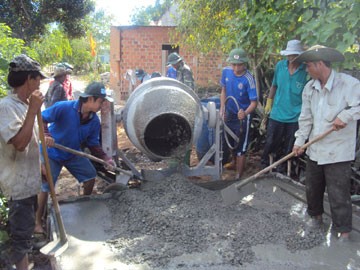(VOVworld) – Xuan Lanh commune in Dong Xuan district, Phu Yen province, has been developing toward a modern socio-economic infrastructure and appropriate production models. Since the beginning of this year, the commune has invested in upgrading its water supply and rural roads and adopting new varieties of animals and high-yield plants.

Xuan Lanh people get involved in paving rural roads (photo: baophuyen.com.vn) |
Xuan Lanh commune is like a busy construction site. People are eagerly getting involved in building 20 km of roads. Ho Thanh Hai, Vice Chairman of Xuan Lanh commune’s People’s Committee, said the infrastructure - electric grid, schools, health centers, and irrigation system – is nearly completed. Hai says: “At the beginning of the new rural areas campaign, young people were mobilized to pave roads. Many road paving sessions are needed. We will then repair our school infrastructure.”
Local officials have held many public meetings to decide on the construction of 20 km of roads. Commune and hamlet officials have informed people about the national new rural development program so they will understand its benefits. Mang Nuu is Head of Ha Tai hamlet. “The people are happy because the state provides materials such as cement and the people contribute labor. They donate land for building roads. They understand that new roads will help them. More than 20 households near my house donated land for road expansion.”
Members of the Youth Union have been pro-active in building new rural areas. Pham Thi Thuy Nga is Secretary of the communal Youth Union. “Every Youth member contributes 2 work days to helping the volunteer group build roads. We have been involved in land clearance to prepare for public works construction.”
Besides building infrastructure, Xuan Lanh’s authorities and citizens’ have also focused on economic development. In recent years, the commune’s agricultural and fishery extension office has taught farmers better ways of farming and raising animals. The people have learned to plant high-yield cassava and sugarcane, which are traditional plants for hilly soil. Mr. Hai says: “We used to plant cassava and sugarcane. On the same areas, we planted many seedlings but the productivity was still low and the farmers suffered losses. Now we apply new techniques, we plant fewer seedlings but the productivity is high.”
Restoring and promoting cultural values are among Xuan Lanh commune’s successes in building new rural areas. Musical instruments, folk dances, and songs of the Cham and Bana ethnic groups have been preserved. Mr. Hai again: “Cultural officials have collected traditional musical instruments. Ha Rai and Xi Thoai hamlet have bought and repaired broken Gongs. Traditional musical instruments of the Cham and Bana ethnic groups have been taught to young people.”
Besides traditional stilt-houses, new concrete houses have been built in Xuan Lanh. The ethnic minority people have changed their outlook and have adopted an advanced lifestyle to catch up with national development.
Lan Anh